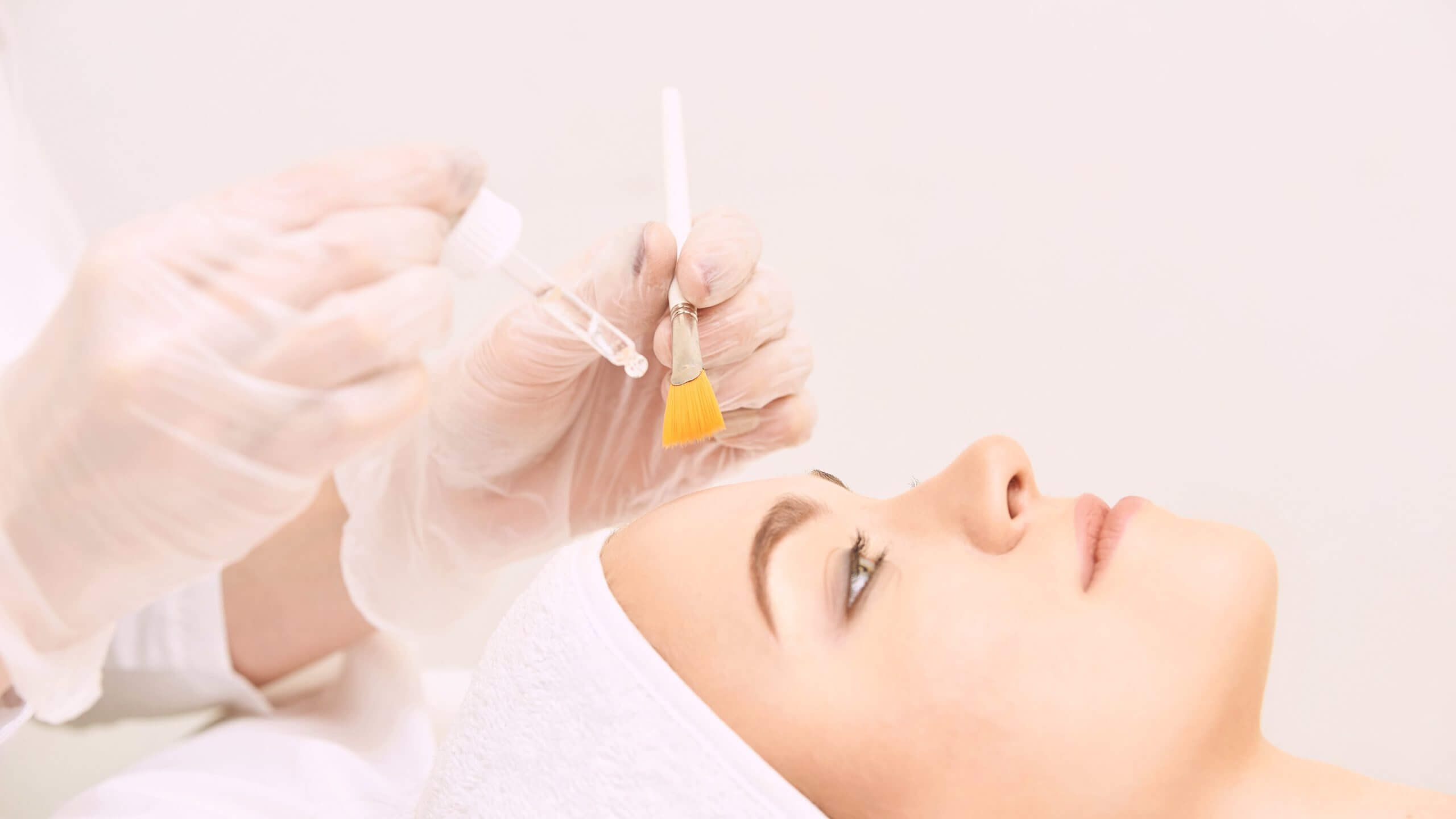Introduction
A glowing, flawless complexion that radiates confidence and beauty. Your skin, your body’s largest organ, deserves the utmost care and attention. In a world where appearances matter, maintaining healthy skin is not just a luxury but a necessity.
In the quest for vibrant and youthful skin, chemical peels have emerged as game-changers. These powerful skincare treatments harness the potential of science and technology to transform your skin from within. They have become more popular due to their remarkable ability to address many skin concerns and deliver remarkable results.
Chemical peels are not mere indulgences but proven methods that can unlock the door to improved skin health and appearance. By delving into the depths of your skin’s needs, chemical peels offer a wide range of benefits, from rejuvenation and acne treatment to correcting sun damage and reducing wrinkles. Prepare to discover the transformative potential that lies within the realm of chemical peels.
Understanding Chemical Peels
Chemical peels are professional skincare treatments that involve the controlled exfoliation of the skin caused by applying a chemical solution and removing damaged outer layers. They accelerate the skin’s natural exfoliation process, revealing fresh, healthier skin.
Types of chemical peels:
- Superficial peels: It is the mildest type of chemical peels. They target the outermost layer of the skin, known as the epidermis. Superficial peels improve skin texture, reduce fine lines and wrinkles, and address mild pigmentation irregularities. They have little to no downtime and are often called “lunchtime peels” for convenience.
- Medium peels: Medium peels penetrate deeper into the skin, reaching the upper layers of the dermis. Medium peels address moderate skin concerns such as acne scars, uneven skin tone, and wrinkles. The skin may require a few days of downtime to heal and recover, but the results can be gratifying.
- Deep peels: The most intensive chemical, penetrating deep into the dermis to address severe skin conditions. Deep peels suit individuals with deep wrinkles, extensive sun damage, or severe acne scarring. Due to their aggressive nature, deep peels require a more extended recovery and are typically performed under sedation or anesthesia. They can provide long-lasting and transformative results, but experienced professionals should only perform them.
The Science Behind Chemical Peels
Overview of the chemical peel process:
- Applying a chemical solution to the skin: A chemical peel involves applying a specifically prepared chemical solution. The solution may contain various acids or other active ingredients that are carefully selected based on the desired depth and results of the peel.
- Chemical exfoliation and removal of damaged skin cells: The chemical solution breaks down the bonds that hold dead and damaged skin cells together. This process triggers controlled exfoliation, allowing the outer layers of the skin to shed. As a result, fresher, healthier skin cells are revealed, leading to a smoother and more youthful complexion.
- Collagen and elastin fibers: Produced in the deeper layers of the skin due to chemical peels, which accelerate this process. Collagen provides structural support, while elastin enhances skin elasticity. The production of these proteins helps improve skin texture, firmness, and overall appearance, promoting a more youthful and rejuvenated look.
Key ingredients used in chemical peels:
- Alpha hydroxy acids (AHAs): AHAs, such as glycolic and lactic acid, are commonly used in chemical peels. They have gentle exfoliating properties and work by dissolving the bonds between dead skin cells, resulting in smoother and brighter skin. AHAs are particularly effective in treating fine lines and mild pigmentation issues and improving skin texture and tone.
- Beta hydroxy acids (BHAs): BHAs, like salicylic acid, are lipophilic, which means they can penetrate deeper into the pores. BHAs are excellent for individuals with acne-prone or oily skin as they can effectively unclog pores, reduce inflammation, and regulate excess sebum production. They are often used in chemical peels targeting acne, blackheads, and whiteheads.
- Trichloroacetic acid (TCA): TCA is a medium-depth peeling agent frequently used in chemical peels. It can penetrate deeper into the skin than AHAs and BHAs, making it practical for treating moderate pigmentation irregularities, fine lines, and sun damage. TCA stimulates collagen production and encourages cell turnover, resulting in smoother, more even-toned skin.
- Phenol: Phenol is a potent exfoliating agent used in deep peels. It deeply penetrates the skin, addressing severe skin concerns such as deep wrinkles, extensive sun damage, and pronounced acne scars. Due to their intensity, phenol peels provide significant results but require longer recovery.
Benefits of Chemical Peels
1. Skin rejuvenation: Chemical peels have the remarkable ability to revive dull and tired-looking skin. By removing dead skin cells and stimulating cellular turnover, chemical peels promote the growth of fresh, new skin cells. This process results in a smoother, brighter complexion and lessens fine lines, wrinkles, and uneven texture. Skin rejuvenation is a crucial benefit of chemical peels, helping individuals achieve a radiant and youthful appearance.
2. Acne and blemish treatment: Chemical peels effectively target acne and reduce the appearance of blemishes and scars. By exfoliating the skin and unclogging pores, chemical peels help to control acne breakouts and minimize the formation of new blemishes. They can also fade post-inflammatory hyperpigmentation, reducing the visibility of acne scars and promoting a more even skin tone. With regular treatments, chemical peels can significantly improve the clarity and smoothness of the skin.
3. Hyperpigmentation and sun damage correction: Chemical peels are a valuable tool for correcting hyperpigmentation and reversing the effects of sun damage. The exfoliating action of chemical peels helps to fade dark spots, sun spots, and melasma, resulting in a more even skin tone. Additionally, chemical peels stimulate the production of new skin cells, which can reduce the appearance of sun damage, such as fine lines, wrinkles, and rough texture. This leads to a brighter, clearer complexion and a more youthful appearance.
4. Wrinkle reduction and anti-aging effects: Chemical peels can effectively diminish the appearance of fine lines and wrinkles, making them a popular choice for individuals seeking anti-aging treatments. By promoting collagen production and enhancing skin elasticity, chemical peels help to plump the skin and reduce the depth of wrinkles. Exfoliation also stimulates the skin’s natural rejuvenation process, improving skin texture and firmness. Regular chemical peel treatments can contribute to a more youthful and smoother complexion.
5. Increased collagen production: One of the long-term benefits of chemical peels is their ability to stimulate collagen production. As we age, collagen production decreases, forming fine lines, wrinkles, and sagging skin. Chemical peels trigger collagen synthesis, promoting the growth of new collagen fibers. Over time, this can improve skin elasticity, firmness, and resilience, leading to a more youthful and rejuvenated appearance.
Preparing for a Chemical Peel
A. Consultation with a dermatologist or skincare professional:
They will assess your skin condition, discuss your skincare goals, and determine if a chemical peel suits you. Professional guidance is essential to ensure the safety and effectiveness of the treatment.
B. Skin assessment:
During the Consultation, your skin will be thoroughly assessed to determine the most appropriate type and strength of chemical peel for your specific needs. This assessment helps to customize the treatment and minimize the risk of complications.
C. Pre-peel instructions:
To maximize the benefits of a chemical peel and minimize the risk of adverse reactions, your skincare professional must follow pre-peel instructions. These instructions may include:
- Discontinuing certain skincare products: You may be advised to stop using certain skincare products, such as retinoids, exfoliants, or harsh cleansers, a few days before the peel. This helps to prepare the skin and minimize potential irritation.
- Avoiding excessive sun exposure: Use sunscreen with a high SPF and limit sun exposure to prevent skin damage.
- Not undergoing other treatments: Your skincare professional may advise against undergoing specific treatments, such as waxing, laser treatments, or microdermabrasion, in the weeks leading up to the peel. These treatments can make the skin more sensitive and increase the risk of complications.
- Informing your skincare professional: It is essential to inform your skin care professional about any medications, allergies, or medical conditions you have. This information helps them tailor the chemical peel treatment to your needs and ensures safety.
The Chemical Peel Process
A. Step-by-step description of a typical chemical peel session:
- Cleansing and preparing the skin: Before the chemical peel, the skin is thoroughly cleansed to remove dirt, oil, or makeup. This ensures that the chemical solution can penetrate the skin effectively.
- Application of the chemical solution: The chemical solution is carefully applied to the skin using a brush or applicator. The solution is evenly spread over the treatment area, and the strength and duration of application are determined based on the type of peel being performed and the desired outcomes.
- Monitoring and timing the peel: During the peel, the skincare professional closely monitors the skin’s reaction to the chemical solution. The duration of the peel is carefully timed to achieve the desired level of exfoliation and skin rejuvenation. The professional may also adjust the application or neutralization process as needed.
- Neutralization and removal of the chemical solution: Once the desired time has elapsed, the chemical solution is neutralized or removed from the skin. This prevents further chemical action and ensures the safety of the skin. Neutralization can be achieved by using a neutralizing solution or rinsing.
B. Discomfort and side effects:
Temporary side effects can occur after a chemical peel, including redness, mild stinging or burning sensation, and peeling of the skin. These side effects are typical and expected as part of the skin’s healing process. The intensity and duration of these side effects may vary depending on the type and strength of the peel. Your skincare professional will provide specific instructions on how to manage any discomfort or side effects that may arise.
C. Downtime and recovery:
Superficial peels typically have minimal downtime, with only mild redness and peeling that resolve within a few days. Medium to deep peels may require a more extended recovery period, from a week to several weeks. During this time, the skin may undergo significant peeling and require special care, such as avoiding sun exposure, using gentle skincare products, and keeping the skin hydrated.
Aftercare and Maintenance
A. Post-peel skincare routine:
After a chemical peel, following a proper post-peel skincare routine is essential to promote healing and maintain the results. Here are some general instructions:
- Gentle cleansing: Use a mild, non-abrasive cleanser to gently cleanse your face twice a day. Avoid scrubbing or using harsh cleansers that can irritate the healing skin.
- Moisturizing: Apply a gentle and hydrating moisturizer to your skin regularly. This helps to replenish moisture and maintain the skin’s barrier function. Opt for moisturizers that are free of harsh ingredients and fragrances.
- Sun protection: Protect your skin from the sun’s harmful UV rays by wearing a broad-spectrum sunscreen with an SPF of 30 or higher. Apply sunscreen and reapply every two hours, especially if you are spending time outdoors. Sun protection is crucial as the skin may be more sensitive to sun damage after a chemical peel.
- Avoid harsh products and treatments: Refrain from using exfoliating products, retinoids, or other harsh treatments until your skin has fully healed. These products can irritate and damage the newly treated skin.
B. Frequency of chemical peel treatments:
The frequency of chemical peel treatments depends on various factors, including the type of peel, the specific skin concerns being addressed, and individual skin characteristics. Generally, here are some guidelines:
- Superficial peels: These gentle peels can be incorporated into a regular skincare routine to maintain skin health and address mild concerns.
- Medium peels: Medium peels may require longer intervals between treatments, typically every three to six months. These peels provide more significant results and deeper exfoliation, targeting moderate skin concerns.
- Deep peels: Deep peels are intensive treatments and are less frequent, often performed once or twice a year. Due to their depth and intensity, they require more downtime and a more extended recovery period.
Conclusion
The transformative potential of Casa Glow’s chemical peels is genuinely remarkable, providing individuals with a pathway to achieve the radiant and rejuvenated skin they desire. Chemical peels have emerged as powerful tools in skincare, and Casa Glow stands at the forefront of this field, offering exceptional and transformative treatments. By embracing the expertise and innovation of Casa Glow’s chemical peels, individuals can unlock the potential for radiant and rejuvenated skin, ultimately enhancing their confidence and overall well-being.
Choose Casa Glow’s chemical peels and embark on a journey toward a more radiant and rejuvenated you. Experience the transformative power of their treatments and witness firsthand the remarkable benefits they offer. Your skin deserves the best, and Casa Glow is here to provide just that.







